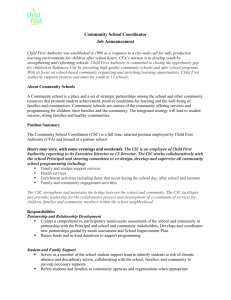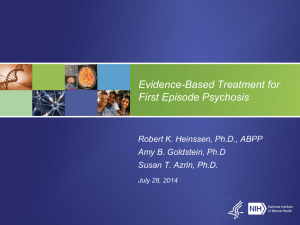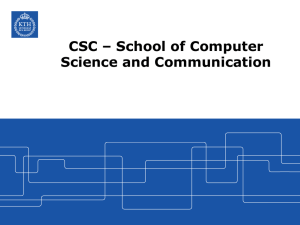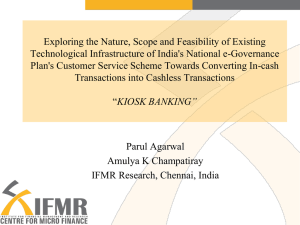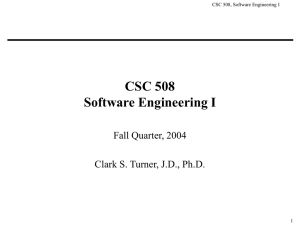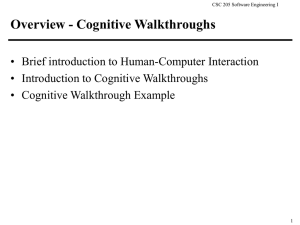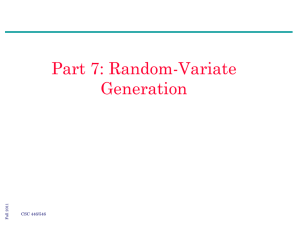PenetrationTesting - file - Northern Kentucky University
advertisement
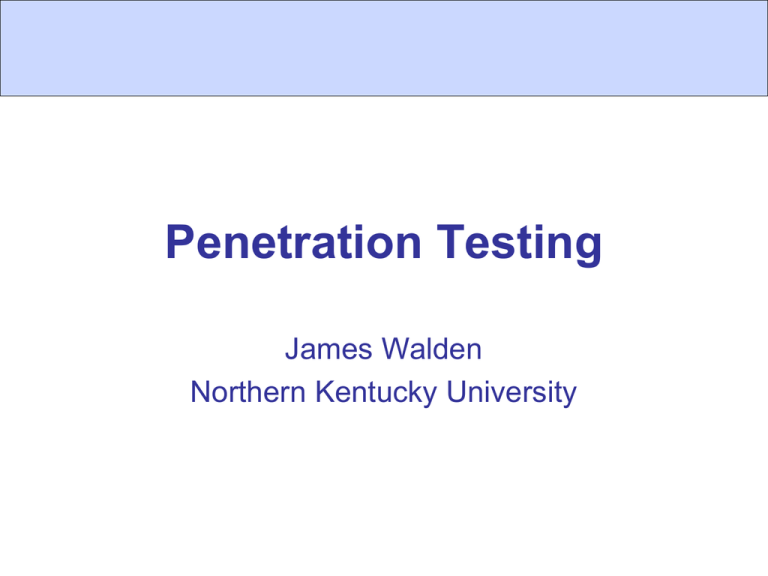
Penetration Testing James Walden Northern Kentucky University Topics 1. 2. 3. 4. 5. 6. What is Penetration Testing? Rules of Engagement Penetration Testing Process Map the Application Analyze the Application Exploit the Application CSC 666: Secure Software Engineering What is Pen Testing? Security testing is the process of providing evidence of how well an application satisfies its security requirements. Penetration testing is a method of security testing, in which testers simulate the efforts of attackers. CSC 666: Secure Software Engineering What is Pen Testing? Penetration testing evaluates the security of software in its deployed environment. Effect of firewalls Deployed cryptographic libraries Effect of other security services and processes Abuse Cases Requirements Risk Analysis Design Code Reviews + Static Analysis Coding Security Testing Testing CSC 666: Secure Software Engineering Penetration Security Testing Operations Maintenance Purposes of Pen Tests 1. Identify vulnerabilities that may be difficult or impossible to detect in design or code reviews. 2. Determine the feasibility of certain attacks. 3. Assess the impact of potential attacks. 4. Test the ability of system to detect attacks. 5. Provide evidence to support increased investments in security. CSC 666: Secure Software Engineering Black, White, Grey Box Testing CSC 666: Secure Software Engineering Rules of Engagement Which systems are being tested? Deployment or development? Web, DB, others? What tests will be performed? Read-only Read-write DoS When will the tests be performed? Who to contact if tests cause problems? CSC 666: Secure Software Engineering Penetration Testing Process Map the Application Analyze the Application CSC 666: Secure Software Engineering Exploit the Application Map the Application 1. 2. 3. 4. Manual following of all links with browser. Automatic mapping with a spider. User-driven spidering of site. Finding hidden content. CSC 666: Secure Software Engineering Automatic Mapping CSC 666: Secure Software Engineering Automatic Mapping Limitations 1. Difficult to parse complex JavaScript menus. 2. Unable to see links in many types of objects, like Flash or Java. 3. Spider may not fill out every form field correctly to get to next step in processes like user registration, billing, etc. 4. Form-based navigation may use the same URL for each step, causing spider to ignore multiple requests to a URL already cached. 5. Spider may terminate its session by selecting Logout link before map is complete. CSC 666: Secure Software Engineering User-Directed Spidering Point browser at proxy tool. User browses through site as normal. User handles authentication and filling out complex forms. Proxy builds map of site. Parses out all links from HTML to add to map, but does not follow them automatically. CSC 666: Secure Software Engineering Finding Hidden Content Check HTML for comments, hidden fields + Try URLs that are not links to find Backup files, e.g. end in ~ or .bak - View source code - Possibility find db login credentials Backup archives of entire site Admin directories - Access admin functionality without credentials Log files - May contain credentials or session IDs CSC 666: Secure Software Engineering Finding Hidden Content CSC 666: Secure Software Engineering Finding Hidden Content CSC 666: Secure Software Engineering Analyze the Application 1. Application core functionality. 2. Peripheral functionality, like administrative, logging, and redirection services. 3. Security mechanisms, including 1. Authentication and password management. 2. Access control. 3. Session management. 4. Client-side technologies (JS, cookies, etc.) 5. Server-side technologies (PHP/JSP, DB, etc.) 6. All entry points where application accepts input. CSC 666: Secure Software Engineering Identifying Entry Points Every URL up to the query string marker Every parameter within URL query string Every parameter submitted within the body of a POST request Every cookie Every HTTP header that the app may process, especially User-Agent, Referer, Host, and Accept headers. CSC 666: Secure Software Engineering HTTP Fingerprinting CSC 666: Secure Software Engineering Exploiting the Application CSC 666: Secure Software Engineering Fuzz Testing 1. Data Set Template Create a template based on the protocol used by the application. Ex: GET /query?[ ]&[ ] HTTP/1.1 2. Value Manipulation Replace template placeholders with random values from data set (numeric, alphabetic, etc.) 3. Application Monitoring Send data and monitor application behavior. Does app crash, error, send unusual responses? CSC 666: Secure Software Engineering Web App Pen Test Work Flow CSC 666: Secure Software Engineering References 1. 2. 3. 4. 5. 6. CERT, Black Box Security Testing Tools, https://buildsecurityin.uscert.gov/bsi/articles/tools/black-box/261-BSI.html, 2009. Patrick Engebretson, The Basics of Hacking and Penetration Testing, Syngress, 2011. NIST, Technical Guide to Information Security Testing and Assessment, NIST Special Publication 800-115, 2008. PCI Security Standards Council, PCI DSS Requirements and Security Assessment Procedures, v1.2, 2008. Dafydd Stuttart and Marcus Pinto, The Web Application Hacker’s Handbook 2nd edition, Wiley, 2011. Kenneth R. van Wyk, Adapting Penetration Testing for Software Development Purposes, https://buildsecurityin.uscert.gov/bsi/articles/best-practices/penetration/655-BSI.html, 2008. CSC 666: Secure Software Engineering
